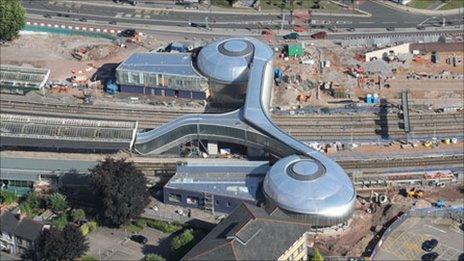New Newport station ready for Ryder Cup
- Published

Network Rail said engineers will be putting the finishing touches to the station over the next two weeks
Newport' new £22m railway station will open in time for one of golf's biggest events, it has been confirmed.
Network Rail said the futuristic station, featuring a roof built with the same material as the Eden Project in Cornwall, will open on 13 September.
Visitors attending the Ryder Cup at the Celtic Manor Resort in Newport from 1-3 October will be among the first to experience the new-look station.
The new development is almost twice the size of the old building.
Up to 100 engineers will be putting the finishing touches to the station over the next two weeks, building pavements, tiling floors and fitting out the interior.
Councillor Matthew Evans, leader of Newport council, said: "I'm looking forward to the opening of the new railway station, which I believe will create a lasting legacy for the benefit of all Newport residents as well as further enhancing the city's position as the main transport gateway for south Wales."
There are two new concourses, with improved information points and more shops, and an additional new entrance to serve passengers from the northern side of the city.
The station will also have three lifts, CCTV and new waiting shelters.
Mark Langman, area general manager for Network Rail, said: "Work continues on schedule to meet our deadline and we will keep working hard over the next two weeks to deliver this scheme for passengers.
Eden Project
"Wales relies on rail and the brand new Newport station is a great example of how rail industry partners are working together to bring Wales' stations into the 21st Century, encouraging even greater use of the railway network."
The scheme has been funded by Network Rail and the Welsh Assembly Government, with support from Arriva Trains Wales and Newport council.
Network Rail said the station had been developed with the environment in mind, with the "bubble wrap" roof built using a material, ethylene tetrafluoroethylene, used by the Eden Project.
The material is said to be recyclable and does not degrade under ultra-violet light or atmospheric pollution.
The station can also capture and re-use rain water, and the space in the public concourses is naturally ventilated.
The designers said a "key consideration" was how to minimise the building's energy demands and carbon emissions.
- Published18 June 2010